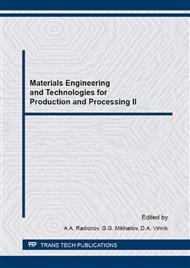[1]
O.A. Esin, P.V. Geld, Physical chemistry of pyrometallurgical processes, Metallurgy, Sverdlovsk, (1962).
Google Scholar
[2]
S.T. Rostovtsev, Theory of metallurgical processes, Metallurgy, Moscow, (1956).
Google Scholar
[3]
S.T. Rostovtsev, V.K. Simonov, A.K. Ashin, O.L. Kostelov, The mechanism of carbothermic reduction of metal oxides, The mechanism and kinetics of metals reduction, Nauka, Moscow, 1970, pp.24-31.
Google Scholar
[4]
V.P. Elyutin, Yu.A. Pavlov, V.P. Polyakov, S.B. Sheboldaev, The reaction of metal oxides with carbon, Metallurgy, Moscow, (1976).
Google Scholar
[5]
B.V. Lvov, On the mechanism and kinetics of the carbothermic reduction of oxides, Izvestia. Ferrous Metallurgy. 1 (1986) 4-9.
Google Scholar
[6]
V.E. Roshchin, A.V. Roshchin, N.V. Malkov, The electrochemical mechanism of pyrometallurgical reduction of disseminated chromite ore, Electrometallurgy. 6 (2000) 38-44.
Google Scholar
[7]
V.E. Roshchin, A.V. Roshchin, Development of the theory of metals reduction, Modern problems of steel electrometallurgy: Materials of XVI International Conference, Chelyabinsk. (2015) 26-35.
Google Scholar
[8]
G.P. Shveikin, Features of the reduction mechanism of refractory metal oxides with carbon, Physical and chemical bases and mechanism of reactions in solids, UC USSR Academy of Sciences, Sverdlovsk, 1976, pp.172-188.
Google Scholar
[9]
V.D. Lyubimov, G.P. Shveikin, Yu.D. Afonin, Study of gaseous products of the reduction reactions of transition metal oxides with carbon, Russian metallurgy (Metally). 2 (1984) 57-66.
Google Scholar
[10]
S.V. Digonsky, New methods of producing metals from their oxidized compounds, Nauka, St. Petersburg, (1998).
Google Scholar
[11]
S.V. Digonsky, V.V. Ten, Role of hydrogen in metal oxide reduction by solid carbon, International Scientific Journal for Alternative Energy and Ecology. 11 (2009) 45-55.
Google Scholar
[12]
V.P. Chernobrovin, I. Yu. Pashkeev, G.G. Mikhailov, A.A. Lykasov, A.V. Senin, O.A. Tolkanov, Theoretical foundations of carbon ferrochrome production processes from the Ural ores, Publishing house SUSU, Chelyabinsk, (2004).
Google Scholar
[13]
A.V. Senin, V.P. Chernobrovin, G.G. Mikhailov, I. Yu. Pashkeev, Thermodynamic analysis of reduction the chromium-containing oxides by gaseous reductants, Izvestia: Ferrous Metallurgy. 7 (2005) 6-10.
Google Scholar
[14]
A.V. Senin, Thermodynamic analysis of the interaction of FeO and FeCr2O4 with gaseous carbon-containing reductants, Vestnik SUSU: series of metallurgy. 13 (2013) 14-18.
Google Scholar
[15]
A.V. Senin, L.S. Kupriyanov, Thermodynamic analysis of the interaction of Cr2O3 and MgCr2O4 with gaseous carbon-containing reductants, Vestnik SUSU: series of metallurgy. 13 (2013) 139-141.
Google Scholar
[16]
A.V. Senin, V.P. Chernobrovin, G.G. Mikhailov, I. Yu. Pashkeev, O.V. Kuznetsova, Research the reduction of ferrochromite by carbon, Steel. 11 (2004) 41-45.
Google Scholar
[17]
A.V. Senin, I. Yu. Pashkeev, G.G. Mikhailov, O.A. Tolkanov, Features of structure and carbothermic reduction Ural chrome ores, Vestnik SUSU: series of metallurgy. 3 (2003) 7-13.
Google Scholar
[18]
A.V. Senin, V.P. Chernobrovin, I. Yu. Pashkeev, Thermal decomposition of serpentine and chlorite in chromium ores, Vestnik SUSU: series of metallurgy. 8 (2004) 46-48.
Google Scholar
[19]
A.V. Senin, T.A. Muksinova, O.V. Kuznetsova, Porosity of chrome ore after heating under reducing conditions, Vestnik SUSU: series of metallurgy. 13 (2007) 17-18.
Google Scholar
[20]
A.V. Senin, Change of the porosity of chrome ore in the carbothermic solid-state reduction, Electrometallurgy. 4 (2012) 11-16.
Google Scholar
[21]
A.V. Senin, Solidphase reduction of chromium ore by methane, Electrometallurgy. 1 (2013) 31-37.
Google Scholar


